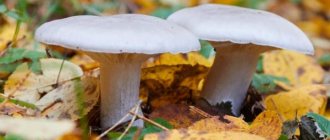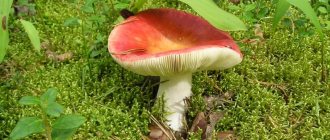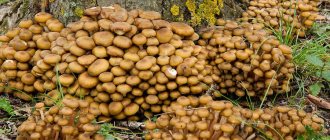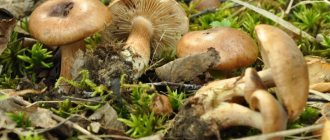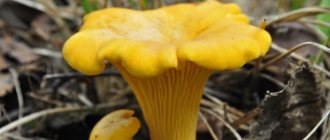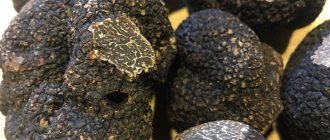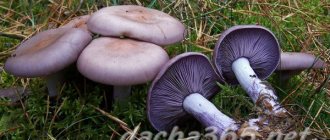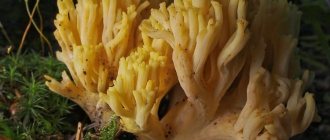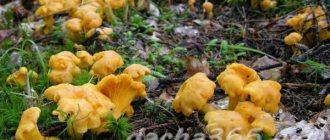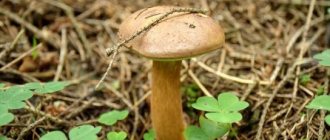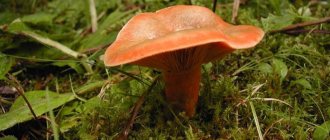Mushroom picking or silent hunting is a very exciting and rewarding activity. They are tasty and healthy, if, of course, you know exactly the “right” mushroom, that is, you approach this activity competently in order to avoid sad consequences.
At the same time as edible mushrooms, their poisonous counterparts also emerge.
Difference and description of rows
In nature, row mushrooms are found both poisonous and edible, but they can be eaten only after careful processing (after boiling). It is quite difficult to distinguish them, since they are very similar in appearance, so before collecting it is important to study the photo and description of row mushrooms.
Thus, poisonous mushrooms have smooth caps that are painted exclusively white and have an unpleasant, pungent odor.
Edible ones look more attractive - they come in different colors (pink, purple, lilac, gray and similar colors), with a stem of the corresponding shade. Under the mushroom cap there are bright yellow plates. If you cut the mushroom lengthwise, you will see that the flesh will be the same color as the plates.
Row mushrooms can be found in the fall (from September to the very end of October) in the forest on the surface of the forest floor or on the soil among moss. They especially bear fruit in large “friendly” groups after the first autumn frosts.According to the description of experienced mushroom pickers, rows, or rather some of their types, have an exceptional unique taste, but each of them is worth trying.
Features of a pine forest
In pine forests, in addition to the pines themselves, you can find many deciduous trees, spruces and various conifers. Very often you can find linden, oaks, birch or aspen. Such forest spaces are most common in the forest or forest-steppe zone. Pines grow and bear fruit quickly due to the constant process of deforestation and incidents of fires.
Forests differ from urban areas in increased precipitation and air humidity. Nearby fields also have the same quality. The roots perform the function of strengthening mountain slopes, so they are usually assessed as developed and quite powerful. The roots reduce mudflows and avalanches.
High-quality material can be obtained from pine, and some sections of the trunks are used for medicinal purposes. In the forest you can find nut bushes, edible specimens of the forest kingdom and berries.
Main types of rows
The row family includes more than 2 thousand species, but not all of them grow in Russia. Here are the most common ones:
Violet - edible rows on a dense stem thickened towards the bottom with a flat convex cap, the edges of which are curved inward. The color of this species must have a violet hue.
The pulp of the mushroom is fleshy and dense with a pleasant smell; over time it burns out and becomes light and hollow.The row is goose or two-color. The mushroom is cream or beige in color, dense with a cap diameter of a maximum of 15 centimeters. Whitish plates under the cap are quite often located.
The giant row or white piglet lives up to its name, that is, a large mushroom with a large massive cap (diameter about 40 centimeters).
The skin is white in color and covered with small scales. The cap is wrapped inside the mushroom in the form of a funnel. The short thick stem is covered with white fibers with a coating in the form of flour.
A special type of mushroom is the May row mushroom or St. George's mushroom. The name is directly related to fruiting immediately after the snow melts in May; they can be found in almost any forest belt.
This species is quite unpretentious and does not require special conditions for growth. But with the onset of summer, the mushroom completely disappears.
St. George's mushroom has no competitors, since the bulk of the harvest usually occurs in the autumn season, and its color cannot be ignored.
Edible varieties
Every experienced specialist, who has been doing what he loves for many years, clearly knows where to find edible and tasty specimens. Much may depend on climatic conditions and any substances prevailing in the area. Representatives of the forest kingdom can be found both on the surface of the earth and on a tree trunk or on a stone. Let's look at a few of the most common individuals growing in pine forests.
Late oiler
This specimen has other names: autumn, yellow or ordinary. It has convex tops of brownish colors, a slimy surface and a skin that can be easily separated. The tubes grow to the lower parts and are pale yellow in color.
Closer to the caps, the lower parts have a beautiful lemon tone, and closer to the base and roots they begin to acquire brown shades and a cylindrical shape. The legs have rings, which is a distinguishing characteristic of the late oiler from the red oiler.
The representative has soft and juicy at the tops, fibrous in the lower parts, whitish pulp. If you cut it, it will turn yellow. Often found on sandy soil alone or in small groups, witch rings. The fruiting period can be determined from May to early November.
The oiler loves rain, so it appears 2 or 3 days after it. Prefers temperatures not exceeding 23 degrees. In the summer, many insects can fly in, and during the fall, butterflies are not eaten by worms. The representative is distinguished by a high content of useful elements and healing properties. Boletus is ahead of even boletus mushrooms in terms of benefits for the human body.
Autumn honey fungus
Honey mushrooms can be found under a pine tree, on the surface of the earth. They prefer to grow in large groups and occupy large areas. Honey mushrooms have a convex cap with edges that sometimes curve upward. Individuals can be found in different colors, with yellow and brown colors most often predominating.
As individuals mature, the surfaces burst and a huge number of dark scales are formed. The honey fungus has a white lower component, which has a cylindrical shape. The pulp can be described as fibrous and whitish. Honey mushrooms require heat treatment before consumption.
The representative has a mushroom smell, but the taste is not very noticeable, it has something similar to cheese. The fruiting period can be defined as the beginning of July and the end of October. Most often found on a tree. Increased yield levels are observed throughout August. This specimen looks like a dark, thin-legged, bulbous-legged and withered honey mushroom.
Greenfinch
Greenfinches are a type of rowing. They got their name because of the green-yellow tone of the fruiting bodies. They prefer medium-aged forests and grow either alone or in small or large groups.
The greenfinch does not like warm weather and a lot of sunlight, so it can be found in darkened areas of the forest. For example, it is worth looking under fallen pine needles or under the soil. Greenfinches have straight legs that tend to widen as they approach the base.
The representative prefers sand and has a sticky surface. It is always found dirty, so before heat treatment and consumption, it must be washed very well under running water. For patients who have poor blood clotting, allergic reactions, kidney disease and pregnancy, the use of greenfinches is contraindicated.
The fruiting period can be considered the beginning of August and the end of September. Can be found growing individually or in groups, usually containing 8-9 pieces. Worms rarely settle in greenfinches.
White pine mushroom
At first, the caps take on hemispherical shapes, after which they become convex and acquire brown and red shades. White pine has a large and swollen stem that is lighter in color than the top. On the lower sections you can find an elegant red mesh pattern.
The representative has high taste qualities; chefs are accustomed to adding it to the most delicious dishes. The specimen has a mild taste and aroma. When you cut the flesh, it takes on a pinkish tint, and in its overall state it has a milky color.
The fruiting period is determined by the beginning of June and the beginning of October. This is a fairly rare find, so experts treat it with the utmost caution. It can easily be confused with a poisonous counterpart, for example, with a satanic and bilious representative.
The white pine specimen is distinguished by a smooth, sometimes uneven, grooved or covered with numerous small tubercles surface. The skin is difficult to separate. The representative can change color to light chestnut shades and acquire purple reflections. The edges have lighter tones.
It is worth giving preference to young individuals, since adults in most cases are affected by worms or other insects.
Real fox
Chanterelles have a unique structure, so they are difficult to confuse with their poisonous and dangerous counterparts. It prefers damp places and likes heavy rains, after which it grows in large groups and can occupy a large area.
Chanterelles are most often small and have a beautiful orange color. The top is funnel-shaped and has folds on the bottom. The upper sections gradually transform into the legs. The skin and dense pulp are separated with difficulty.
Interestingly, real chanterelle has a pleasant fruity smell and has dense, elastic flesh. It prefers mosses, and the period of fruiting and peak yield can be considered the period from the end of May to the end of October.
In appearance, chanterelles resemble yellow hedgehogs, but the hedgehog has a cap that is not fused with the lower part. The counterpart of the real chanterelle is the false chanterelle, with which they differ in color and shape.
Saffron milk caps
Saffron milk caps also have other names. They are also called true saffron milk caps, pine mushrooms or autumn mushrooms. They have a thick, fleshy, funnel-shaped top, which then tends to take on a flat shape with the edges arching upward. Saffron milk caps are characterized by pleasant orange colors.
Camelina has brittle, orange flesh that turns greenish when cut, and the cylindrical lower areas are the same color as the upper parts. The pulp can be described as soft and fragile, has a pleasant smell and pungent taste.
Most often it is used to pickle or marinate. Sometimes it is fried in a frying pan with other ingredients, but not dried; it is not suitable for this. The period of fruiting and peak yield is determined by July and the end of September. Saffron milk caps do not like cold weather; they can most often be found at the edge of the forest.
Variegated hedgehog
It has flat-curved tops, covered with a huge number of tiled scales of brown colors. The legs are solid, cylindrical in shape, having the same color as the caps or lighter. The pulp can be called thick, quite dense, gray-white in color, pleasant in taste and smell.
Variegated hedgehog is eaten in all forms, but experienced mycologists note that fried hedgehog is tastier than all other cooking methods. This is a very rare find and prefers sandy or dry soils. Blackberry grows in small groups.
The fruiting period can be determined by the beginning of August and the end of November; many variegated hedgehogs are confused with Finnish and rough hedgehogs. The main difference is the taste. Bitter counterparts give off a bitter aftertaste.
Purple moth
Young individuals of the purple fly have a neat round shape, but older representatives acquire funnel-shaped shapes. Mokruha has brown-lilac and sometimes reddish colors. It has a smooth and rather slimy surface.
The pulp can be called thick, with a lack of aroma and taste. The lower areas are curved, having a color similar to the upper part. The lower sections have silky surfaces. Mokrukha prefers to grow in small groups, and it can be seen rarely.
The main fruiting period is August-September. Can be confused with pink or spruce mokrukha. The main difference is the color of the caps.
Polish mushroom
It has a hemispherical and convex cap, which can acquire various brownish shades. The skin can be called smooth and quite dry. The lower region is cylindrical in shape, quite dense, yellow-brown in color.
The pulp can be described as dense, with a pleasant fruity aroma and sweet taste. As the pulp matures, it acquires a more fragile consistency. Inexperienced experts may confuse the Polish specimen with white pine specimens or green moss mushrooms.
The fruiting period is summer and early autumn. The best solution for cooking is marinating and drying.
Photo of row mushroom
Shiitake - appearance, composition, benefits and harm, mushroom cultivation + 72 photos- Talker - description of the species, distribution of the species, benefits and harm + 79 photos
- Gall mushroom - description of appearance, seasonality, taste + 69 photos
Edibility of rubella
Rubella is an edible mushroom, despite the fact that in appearance it is very similar to a number of inedible mushrooms, so inexperienced mushroom pickers avoid it. In addition to edibility, it is also necessary to discuss the taste of these mushrooms. The milkweed very rarely ends up in mushroom pickers' baskets. It is collected only when there are no alternatives, and on a quiet hunt it was not possible to find anything better. However, connoisseurs assure that rubella is an ideal mushroom for cooking; they are sincerely perplexed why others avoid it. Fresh rubella has a pleasant aroma. However, its juice is quite bitter in taste and a little tart. That is why the mushroom was assigned “category 4” of taste.
However, after appropriate procedures in the form of heat treatment, the taste is much better, and the bitterness gradually goes away, leaving a very pleasant aftertaste. The mushroom becomes spicy and slightly tart, adding some zest to some dishes. Therefore, some chefs have no idea how to cook certain types of dishes without rubella.
Boletus
This mushroom is tubular. In terms of its value, it ranks second after honey mushrooms. The cap of the boletus is quite fleshy, brown-red in color. Sometimes you can find boletuses with a white cap; they are no different from ordinary ones. The leg of boletuses is quite thick, widens towards the base, and has many dark gray scales.
The places where these mushrooms grow can be determined by their name. They can be found under aspens and other deciduous trees.
The best time to look for boletus is from mid-July to the end of October. If you collect these mushrooms after long rains, beware of picking up worms, since in the abundance of moisture they very quickly appear in the boletus. Dry weather conditions with variable precipitation are more favorable for them.
These mushrooms grow in groups, so finding them is quite easy.
Mosswort
Moss fly mushrooms are found in almost all forests of our country. The cap of this mushroom reaches 15 cm in diameter, it has a convex shape and a tubular base. The edges of the cap droop with age. The color of the cap can vary from marsh green to yellow-brown. The stem of this mushroom is smooth, slightly narrowed closer to the base, and has a smooth surface.
Most often, moss mushrooms are pickled, this is how its taste is expressed most clearly.
Recipes for making rubellas
As you have already seen, rubella is an edible mushroom, including a widespread one. It is a pleasure to cook, but before moving on to the recipes, we suggest you find out how to properly prepare the mushroom for subsequent processing.
Rubella is a mushroom that, despite its usefulness, can absorb negative substances and toxins. Especially if you picked it close to the roadway or production. Therefore, in order to protect yourself as much as possible from the influence of negative substances, we strongly recommend that you carry out the treatment.
- To begin with, all needles, debris, pieces of earth and insects are removed from the total mass of collected mushrooms.
- Then the mushrooms are thoroughly washed under running cold water.
- After this, the redfish are carefully soaked with a towel, after which the skin is removed. This is done very consistently and carefully.
- After the skin has been removed, the cap is separated from the legs.
- The mushrooms are carefully washed again under running cold water and placed in a saucepan. It is filled with cold water. Mushrooms are soaked for a period of 1 hour to several days.
- After this, they are taken out and dried well with a towel. Place a pan of clean cold water on the fire. They wait for it to boil and send the mushrooms there. The mushrooms are cooked for 20 minutes, after which they are completely ready to eat.
- Now that the mushrooms are ready, you can move on to different options and recipes. By the way, after appropriate processing, the mushrooms have lost their bitter taste, which means they will be an excellent addition to any dish.
Mushroom pate
Since rubellas are found in very large quantities in modern forests, they can be used to prepare a dish that will allow you to use the maximum amount of these mushrooms. The recipe for mushroom pate is perfect for this.
- To prepare it, you will need already properly prepared and heat-treated rubellas. They are carefully washed with water and then cut into small pieces.
- You will need an onion, which is also cut into small pieces.
- Do the same with garlic.
- Add a couple of spoons of sour cream.
- Chop your favorite greens.
- All ingredients are placed in a blender bowl. Then, it is launched.
- The crushed mass is placed in a special container and put in the refrigerator.
You can use the mixture the next day; it spreads perfectly over the bread and has a pleasant taste and aroma. If desired, you can add salt, pepper, and a small amount of nutmeg. It turns out very tasty.
Mushroom salad
Another delicious dish that will not leave you indifferent.
- Cut the heat-treated mushrooms into slices.
- They are thoroughly fried in a frying pan.
- Then the mushrooms are removed and the onions are fried in a frying pan until golden brown.
- The ingredients are placed in a salad bowl.
- Then, canned beans are added there.
- Add carrots in Korean style.
- Some corn.
- After that, you can cut boiled chicken breast, ham or balyk as meat.
- Mix everything thoroughly and season with mayonnaise.
- Salt or pepper if desired.
It turns out very tasty, and most importantly satisfying.
Mushrooms with meat and vegetables
If you are a fan of stew, you will not remain indifferent to the following dish.
- So, first you need to process the mushrooms well and cut them into several pieces.
- You will need pork meat. Remove the veins and cut the pork into small cubes.
- Also cut the potatoes.
- Cut the tomato into quarters or more, depending on its size.
- Carrots are cut into slices.
- Onion in half rings.
- Eggplant or zucchini, and sometimes the whole thing is cut in half and into semicircles.
- All ingredients are placed in one container. They are salted, peppered and mixed thoroughly. Then, the baking sheet should be well greased with oil.
- All ingredients are laid out, distributed neatly and evenly.
- Everything is filled with a small amount of water, but not in volume.
- The top of the baking sheet must be carefully covered with foil.
- Set the oven temperature to 220 degrees and wait about 1 hour. After an hour, remove the foil and bake for another 15-20 minutes so that everything is covered with a small crust.
Before serving the dish, it must be decorated with herbs. Ideal if you also make tomato sauce.
The dish is very satisfying and aromatic. The main thing is that rubella does not make other vegetables bitter, they are still tasty and aromatic.
Important! As you have already understood, rubella is a mushroom that belongs to the fourth category of edibility. This means that it is not harmful when eaten, but you need to be careful when choosing recipes. The fact is that if processed improperly or with an incorrectly selected flavor combination, rubella becomes bitter, which means your efforts will be in vain.
How to pickle mushrooms
Salted mushrooms are a real delicacy, especially if the pickling was done according to all the rules.
The rubella will become perfectly soft and salty without bitterness if a certain recipe has been followed. Let's find out what we're talking about.
So, make sure that the mushrooms are thoroughly cooked. This means that they must go through several stages at once.
- First, they need to be washed well and cleared of debris.
- Then, the mushrooms should soak for some time.
- After this, they are cooked on fire for 20 minutes.
- Then, carefully cut the mushrooms in half if the caps are too large. If they are small, they are left whole.
- Peel a few cloves of garlic. Prepare a few peppercorns. Bay leaf.
- Mushrooms must be placed in a container. They are carefully salted and peppered.
- Then add a small amount of vinegar, about one tablespoon.
- Mix everything thoroughly.
- There, a few peppercorns, peeled garlic and bay leaves are added to the mushrooms.
- The contents of the container are laid out in jars. They do it quite tightly. Banks are closing.
Place in a cool place. After a few days, you will see that the entire jar is filled with mushroom juice, which was released as a result of the influence of vinegar and salt. This way the mushrooms continue to marinate in their own juice. After salting like this, they are incredibly tasty and aromatic, the bitterness disappears. Makes an ideal accompaniment and snack.
How to marinate
There is also a very popular, most importantly delicious, marinating recipe. True, for this you will have to bother even more.
To begin with, the mushrooms go through all stages of preparation.
- Thoroughly cleaned of debris.
- Rinse under running cold water.
- I soak for several hours or days.
- Cook in boiling water for 20 minutes.
At the same time, you need to prepare a special marinating composition.
- For 1 liter of water you need to add 2 tablespoons of vinegar.
- Bay leaf is added. A few cloves of garlic. A few cloves of pepper.
- A pinch of salt.
- You can add some cloves if you wish.
- Everything is brought to a boil.
- Then, the solution must be filtered.
- Mushrooms are packed tightly into jars. Fill the top with a slightly cooled solution.
- You need to pour until the solution covers all the mushrooms.
- Then the mushrooms are carefully rolled up.
These pickles must be kept in a cool and dark place. And you can taste it a month after you closed the jars.
The mushrooms turn out very tender, at the same time salty and tasty. And thanks to cloves, bay leaves and other possible spices that you decide to add, the taste remains piquant and interesting. This effect is only possible with rubella mushrooms; unfortunately, it cannot be repeated with other mushrooms. So if you want to experiment, be sure to try these recipes.
Important! It will be ideal if you place the jars on a glassed-in loggia. This is the temperature and coolness that is suitable for pickling mushrooms. They will not be very comfortable in the refrigerator, since the light turns on periodically, and the proximity of cans to other products does not always have a good effect on the taste and quality of the pickling.
